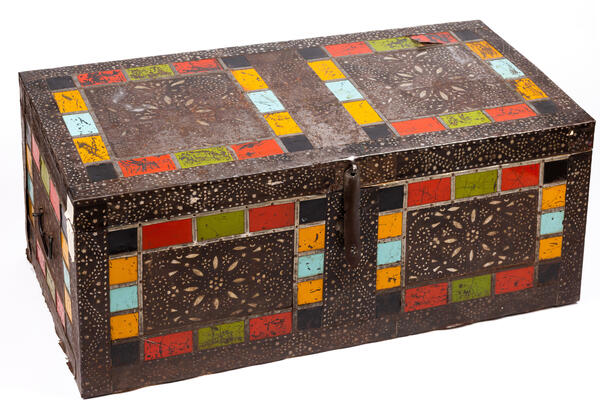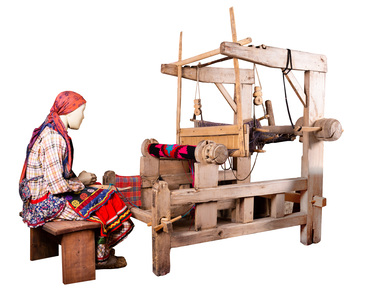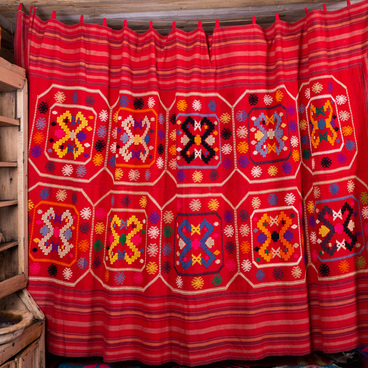A chest is an item that is a piece of cabinetry with a hinged or removable top cover that is used as a container to store everyday household items, jewels, or other valuable items. The name of the chest, sunduk, comes from the Turkic word ‘sandyk’, and since ancient times prototypes of chests have been found across various cultures. Nowadays, the chest is used as a common household item in Kazakh, Russian, and Eastern European villages.
This chest was used in Bashkir dwellings, and this is evidenced by its specific ornamentation and coloring. It was produced in the 20th century. Frequently, tin plates cut from candy boxes, and nailed on the front and sides, could be found as decoration on Bashkir chests. On the sides of the chest, paired handles made of wicker were always attached. Using those, it was convenient to move the chest from one place to another.
The first chests appeared in ancient Egypt. Later on, in Ancient Greece, chests with a paneled frame design became widespread — these chests’ flat surfaces had decorative recesses. Throughout the rest of Europe, chests became widespread during the early Middle Ages. They were also used in medieval China. In medieval Russia, chests were also one of the most common pieces of furniture. During the early Middle Ages, broadly speaking the chest was often the most popular piece of furniture, and one that was virtually universal.
It is believed that the chest became the progenitor of all cabinetry, meaning closed holders used for storing various things. When indoors, chests were most often placed near a wall, but there are options how they can be arranged. Sometimes the chests were put on a bench, or on top of one another, if the family had several of them. Also, chests were often used when going on trips, and for this there were special portable travel chests.
Chests can vary to an extreme degree in appearance, and this changed depending on the culture. Usually, chests were made of durable and valuable wood species. Pine, cedar, and oak were very popular among both artisans and customers. Particular attention was paid to how the chest was decorated, which was often done using durable natural materials, including leather and fabrics. Sometimes the chests were upholstered with exotic materials, for example ostrich or crocodile leather. In order for the chest to retain its durability, and serve for several decades, it was bound with metal slats. The sizes of chests range from a small, artfully decorated box to an oversized trunk.
This chest was used in Bashkir dwellings, and this is evidenced by its specific ornamentation and coloring. It was produced in the 20th century. Frequently, tin plates cut from candy boxes, and nailed on the front and sides, could be found as decoration on Bashkir chests. On the sides of the chest, paired handles made of wicker were always attached. Using those, it was convenient to move the chest from one place to another.
The first chests appeared in ancient Egypt. Later on, in Ancient Greece, chests with a paneled frame design became widespread — these chests’ flat surfaces had decorative recesses. Throughout the rest of Europe, chests became widespread during the early Middle Ages. They were also used in medieval China. In medieval Russia, chests were also one of the most common pieces of furniture. During the early Middle Ages, broadly speaking the chest was often the most popular piece of furniture, and one that was virtually universal.
It is believed that the chest became the progenitor of all cabinetry, meaning closed holders used for storing various things. When indoors, chests were most often placed near a wall, but there are options how they can be arranged. Sometimes the chests were put on a bench, or on top of one another, if the family had several of them. Also, chests were often used when going on trips, and for this there were special portable travel chests.
Chests can vary to an extreme degree in appearance, and this changed depending on the culture. Usually, chests were made of durable and valuable wood species. Pine, cedar, and oak were very popular among both artisans and customers. Particular attention was paid to how the chest was decorated, which was often done using durable natural materials, including leather and fabrics. Sometimes the chests were upholstered with exotic materials, for example ostrich or crocodile leather. In order for the chest to retain its durability, and serve for several decades, it was bound with metal slats. The sizes of chests range from a small, artfully decorated box to an oversized trunk.



